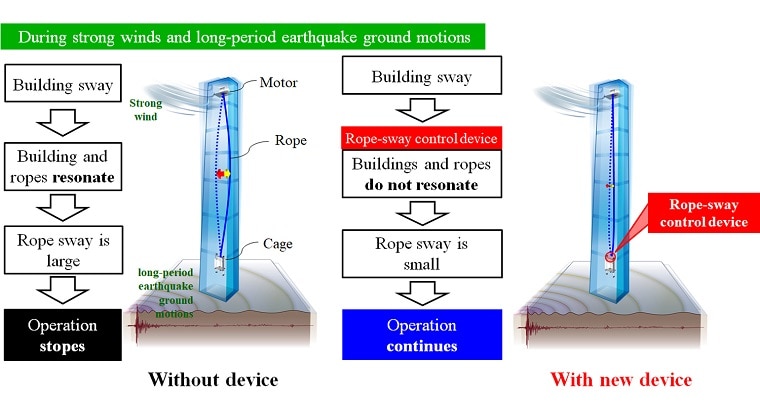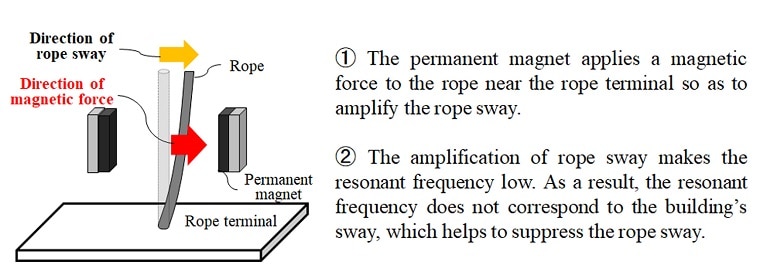FOR IMMEDIATE RELEASE No. 3251
Mitsubishi Electric Develops Passive Rope-sway Control Device for Elevators in High-rise Buildings
Helps reduce elevator shutdowns during strong winds and earthquakes
TOKYO, February 7, 2019 - Mitsubishi Electric Corporation (TOKYO: 6503) announced today that it has developed a device that passively controls rope sway when high-rise building elevator sway due to strong winds or long-period earthquakes. By enabling elevators to continue operating under such conditions, the new device will help to stabilize elevator operations and contribute to greater user convenience.

Rope-sway control technology

Principle of rope-sway control
Mitsubishi Electric's new passive rope-sway control device applies a magnetic force, called negative stiffness, to the bottom-end of the rope. Negative stiffness is a well-known principle, and it applies a force in the opposite direction against a normal spring's restoring force.
Main Features
- 1)
-
More stable elevator operation by greatly suppressing rope sway when building sways
- The magnetic force of permanent magnets is used to amplify the swing of the rope terminal at the top of the car in accordance with the amplitude.
- Lowering the rope's resonant frequency, or the frequency at which it tends to sway, makes it difficult for the building and ropes to resonate and thereby drastically curbs rope sway.
- By reducing operational downtime, the device helps to stabilize elevator operations.
Negative stiffness is achieved by placing permanent magnets facing each other so as to sandwich the rope. The negative stiffness force acts in the same direction as the rope sway, increasing the sway amplitude at the rope terminal as if the terminal's position were unfixed (a rope with one free end has a lower resonance frequency than a rope with two fixed ends). As a result, the building and rope sway at different frequencies, so they do not resonate and rope sway is greatly suppressed. The use of permanent magnets enables elevator operation to be stabilized without using electrical energy. - 2)
-
Successful vibration damping tests on actual elevators
A test that simulated a building swaying due to a long-period earthquake demonstrated that, compared to a rope without a passive rope-sway control device, rope sway could be reduced by at least 55% (magnitude of sway at center of undampened rope = 1).
In a test conducted at Mitsubishi Electric's "SOLAé" elevator test tower (173 meters high) at Inazawa Works. in Japan, the upper end of a rope was shaken at a frequency simulating the sway of a building due to the long-period ground motion of an earthquake. In the absence of any damping device, rope sway exceeded the company's recommended threshold for suspending elevator operation. When the damping device was applied, however, rope sway fell below the threshold.
Note that the releases are accurate at the time of publication but may be subject to change without notice.
